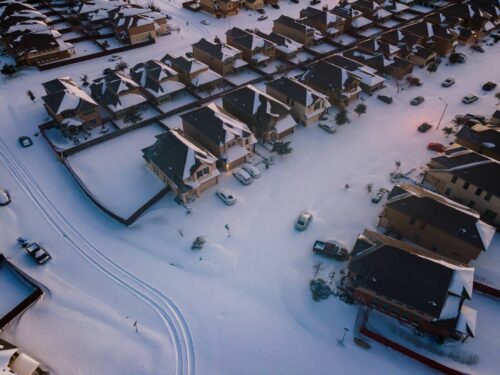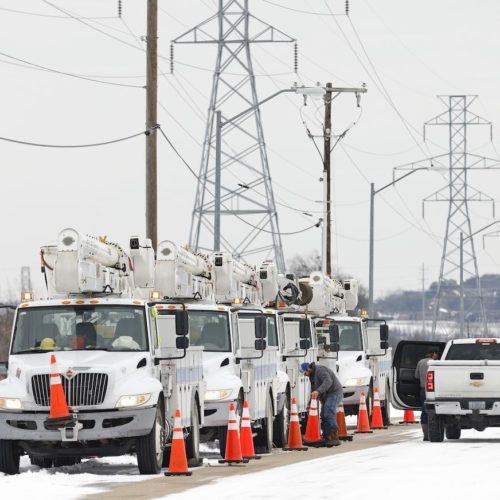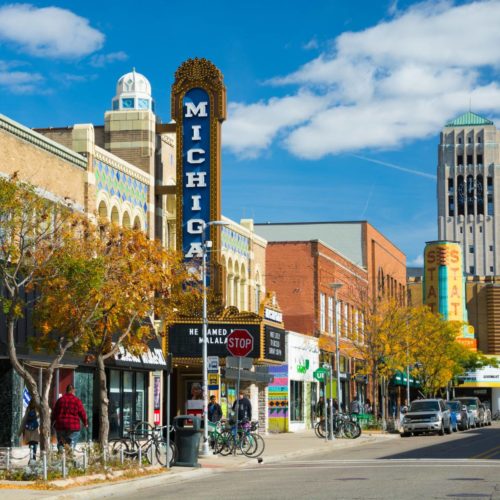
Are We Ready for Another Uri?
How Texas Local Governments Are Building Resilience in the Face of Worsening Climate
Texans recently endured another bout of record low temperatures and icy conditions. While it didn’t compare to the devastating effects of winter storm Uri in 2021, it was a grim reminder of last year’s historic freeze.
When Storm Uri slammed into Texas one year ago to date, it left more than two hundred people dead and close to 4.5 million people without power. The loss of power was due to many reasons, most of which have to do with climate change stressing systems that aren’t built for extreme weather events. Although the state government might not be doing enough to protect the grid against future climate threats, local governments are stepping up to help build resilience in their communities and at the state level.
When temperatures plummeted during Storm Uri, electricity demand to heat homes soared beyond what the Texas grid operator, ERCOT, was prepared for. Texas relies mostly on natural gas (50 percent of its electricity generation), and the cold temperatures limited flow through gas pipelines and caused failures in gas-fired generators.
What Has and Has Not Happened Since Uri
Since Uri, the Texas government has made some progress to overhaul the state’s grid, though arguably not enough.
State lawmakers passed Senate Bill 3 (SB 3) to address generation facility weatherization and grid fixes. Among other things, the new law requires weather emergency preparedness for certain energy facilities, such as electric generation facilities and transmission providers.
PUCT also made moves to improve grid reliability by reforming the state’s wholesale electricity market. Some of these reforms include:
- Providing earlier price signals to bring additional generation online and for large consumers to adjust their demand;
- Increasing incentives for large consumers to decrease electricity usage in response to prices and grid conditions; and
- Implementing new or revamped ancillary services that include paying generators for having on-site fuel storage.
To deal with the financial fallout from Winter Storm Uri, the legislature passed several financing bills including Senate Bill 1580, which enables electric cooperatives to use securitization to recoup costs and expenses resulting from the storm. PUCT also lowered the system-wide cap on the price that generators can sell electricity to help reduce price volatility during scarcity events.
Despite the progress made by the Legislature and regulators, many experts feel that the new laws and the reforms don’t go far enough to tackle the large structural changes the state’s electricity market needs. Although the adoption of SB 3 will result in substantial changes to the weatherization requirements of certain energy facilities, the new law requires only certain gas supply chain facilities that are deemed “critical” by regulators to be able to withstand a weather emergency. Fuel supply issues were not addressed, either—making the state vulnerable to low gas supply as happened during a cold snap last month.
The Legislature also missed an important opportunity to increase the grid’s resilience and reliability with demand-side solutions such as efficiency measures. Demand-side solutions would provide more resilience to the grid but also directly protect Texas residents by ensuring that Texans can safely reside in their homes without the possibility of freezing or over-heating. Unfortunately, two bills to set new energy efficiency standards and increase demand-side resources did not pass.
In addition, legislators and regulators should seek feedback from people affected by storms by incorporating more robust stakeholder and public engagement input processes into their proceedings. Stakeholder input could drive the Commission to consider the role of demand in system failures and push them to expand energy efficiency and weatherization programs.
Stoic Energy President Doug Lewin’s recent article provides an in-depth analysis of what has been done to prevent future outages—and what hasn’t.
Local Texas Governments Are Stepping Up
Fortunately, local governments—which are on the front lines of crisis response and understand and represent the needs of their communities—are stepping up. They are driving resilience while also participating in state-level decisions that impact their communities.
Last year, a group of six local governments banded together to bring their collective voice to PUCT on an important regulatory proceeding revisiting the wholesale electric market design in light of Winter Storm Uri. In a joint letter, these six cities and counties advocated for:
- Energy efficiency and demand response programs to equitably manage electricity supply and demand and improve grid reliability;
- A diversified resource base to provide a variety of grid benefits and services, and further strengthen grid reliability and resilience;
- Minimizing the severity and disproportionate impacts of power outages on certain customers;
- Expanding Texans’ access to reliable electricity by connecting with adjacent grids; and
- Ensuring that there is a robust and inclusive market redesign stakeholder engagement process.
Meanwhile, local governments have also been advancing measures on the ground such as implementing community resilience hubs and accelerating residential weatherization, while focusing on their most vulnerable communities.
Community resilience hubs increase resilience by providing a place of shelter, back-up power, and resource distribution before, during, and after disasters. They act as nodes of communication keeping surrounding residents informed. They also advance social equity by providing shelter and services to low-income and minority neighborhoods, who were hit especially hard during Storm Uri and were more likely to lose power first and have it restored last. Austin has invested $3 million to create tiers of hubs around the city. And Houston has already identified a low-income neighborhood to implement the city’s first resilience hub, working with the community to identify what services should be included.
The inefficient Texas residential building stock was both a cause of the power failure and a major vulnerability exposed by it. The difference between efficient and inefficient buildings—in terms of the “hours of safety” they offered their occupants during the historic freeze—was literally the difference between life and death for some Texans. Home upgrades would not only provide more resilience to extreme weather but would also reduce energy burdens. Low-income households in Texas spend over 12 percent of their incomes on energy expenses, four times the state average.
Local governments are exploring how they can collectively accelerate residential weatherization. Cities are working closely with community action agencies to effectively utilize the increase in residential weatherization funding and build out more weatherization workforce training opportunities.
Local governments are also working on electrifying their municipal fleets to reduce their carbon impact to help mitigate increasingly frequent climate events. Some large cities have been doing this for years and now we’re seeing smaller cities following suit. Cities are developing fleet electrification plans and/or direct procurements of electric vehicles. Transitioning municipal fleets will help mitigate disasters, but they will eventually also act as distributed energy resources, providing or augmenting back-up power for buildings, while also enhancing demand-side flexibility on the grid.
Preparing for Another Uri and Beyond
These efforts by local governments will help them prepare for future severe weather events and provide benefits to their community beyond emergency preparedness. The havoc wreaked by Storm Uri revealed the shortcomings of Texas’ electricity system and while the state is working to adapt its infrastructure and processes for future storms, more likely needs to be done. Luckily, many cities and counties across Texas are raising the bar for what local governments can do to protect their citizens and improve resilience.

